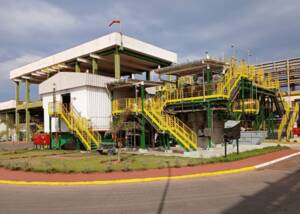Sappi returns to profitability in third financial quarter 2021
News General news
Commenting on the group’s results, Sappi Chief Executive Officer Steve Binnie said: “We have seen a significant improvement in market conditions in the majority of our trading regions during the quarter. This contributed to a material increase in quarter-on-quarter EBITDA and an overall return to profit of US$18 million.”

He continued, “I am particularly pleased with the performance of our packaging and specialities segment which delivered a record EBITDA and validates our strategic investments in this sector. Strong demand and good pricing in the dissolving pulp segment also had a beneficial impact on our South African and North American businesses. In contrast, margins in our European business remained under pressure due to escalating raw material costs and logistical challenges, which constrained export sales.
“As COVID-19 lockdown restrictions continue to ease, we are seeing a steady improvement in global economic activity. This had a positive impact on graphic paper demand in the quarter and the outlook for this segment is expected to improve further with the normalisation of activities in the travel and entertainment sectors. Our focus in this segment is to recover margins through stringent cost management and price increase realisation.
“Despite our improved performance, the quarter has not been without challenges. Logistics continued to be a global obstacle; container availability, port congestion and vessel space remained severely constrained in all of our export shipping routes and freight costs escalated significantly. Additionally, the emergence of more transmissible COVID-19 variants, which are resulting in new waves of infection in countries around the globe, represent an ongoing risk to our employees and business performance. The health and safety of employees is our primary focus and we have embedded strict COVID-19 protocols in the workplace. We actively encourage participation in vaccination programmes and are working closely with South African health authorities to facilitate the vaccination of our employees and their families at our occupational health centres at our operating sites.
“A brief period of civil unrest in South Africa during July caused major disruptions to raw material supplies and forced the temporary closure of three of our mills in KwaZulu-Natal. In the aftermath of the unrest, we worked closely with government and business forums to restore disrupted supply chains and provided immediate assistance to employees, local communities and the South African National Defense Force. The lost production will have an estimated negative impact on our fourth quarter EBITDA of approximately US$16million.”
Looking forward, Binnie stated, “Given the favourable conditions for DP and packaging and specialities combined with tighter graphic paper markets, offset partially by the loss of production volumes from the South African civil unrest and higher raw material costs, we expect an improvement in the fourth quarter EBITDA relative to the third quarter.”
Financial summary for the quarter
- EBITDA excluding special items US$145 million (Q3 FY20 US$26 million; Q2 FY21 US$112 million)
- Net debt of US$2,055 million (Q3 FY20 US$1,977 million)
- Profit for the period US$18 million (Q3 FY20 loss of US$73 million)
- EPS excluding special items 5 US cents (Q3 FY20 -10 US cents)
The quarter-on-quarter improvement in group EBITDA and overall return to profit of US$18 million was driven by strong dissolving pulp (DP) prices and an excellent performance from the packaging and specialities segment. These gains were partially offset by ongoing global logistical challenges which impacted export deliveries and costs in all three regions and lower margins in Europe due to significant input cost inflation.
Higher selling prices facilitated a substantial increase in EBITDA for the DP segment and sentiment generally remained buoyant on the back of steadily improving retail demand in the apparel sector. The average Chinese market price for hardwood DP increased 19% on the prior quarter to US$1,088 per ton. However, increased stock levels of viscose staple fibre (VSF), yarn and grey fabric through the supply chain exerted some downward pressure on the VSF price and consequently led to a gradual reduction in the Chinese DP price at quarter end. DP sales volumes for the quarter were below expectations due to a loss of production volumes at the Saiccor Mill and shipping delays in both South Africa and North America. The planned maintenance shut at Saiccor Mill in May was extended and the subsequent start up took longer than planned, which resulted in a production loss of approximately 40,000 tons. Due to COVID-19 travel restrictions, original equipment vendors were unable to travel to South Africa. As a consequence, the execution of a number of critical projects during the shut was negatively impacted. Shipping delays at quarter end further reduced sales volumes by 21,000 tons.
The EBITDA in the packaging and specialities segment reached a new record high and contributed almost half of the group EBITDA. Sales volumes increased by 23% compared to the equivalent quarter in the prior year and validate the strategic actions taken to reduce exposure to graphic paper through diversification into this segment. The growth in sales volumes and the improved margins are reflective of the encouraging progress in North America to optimise the product mix at the Somerset Mill and a strong containerboard performance in South Africa.
In a positive development, demand for graphic paper improved during the quarter as a result of renewed global economic activity as countries eased COVID-19 lockdown restrictions. Sales volumes in the segment reached 90% of volumes in the pre-COVID equivalent quarter in 2019. The substantial capacity that exited the sector also tightened the market balance. However, profitability in the segment remained under pressure due to spiralling purchased pulp input costs, particularly in Europe, in combination with a lag in selling price increases.
Outlook
During July, incidents of civil unrest in South Africa caused major disruptions to raw material supplies and forced the temporary closure of the Saiccor, Tugela and Stanger Mills in KwaZulu-Natal. A combined total of 28,000 tons of DP and 7,000 tons of paper production were lost, which will have an estimated negative impact on fourth quarter EBITDA of approximately US$16million. The completion and commissioning of the Saiccor Mill expansion project was also negatively impacted by the unrest and ongoing COVID-19 travel restrictions. Therefore, the start-up is projected to be delayed until early in the new financial year.
The outlook for the DP segment remains positive despite a gradual weakening of market pricing in the third quarter. Prices of VSF, cotton and polyester all increased during July which should support DP prices. The fundamental driver of market dynamics in the DP segment is apparel sales, which continue to improve globally quarter-on-quarter as economic activity resumes. The demand from Sappi’s DP customers remains strong and much of the benefit of the elevated third quarter pricing will be realised in the fourth quarter due to the lag in contractual pricing.
The underlying demand in the packaging and specialities segment remains robust particularly in South Africa and North America and opportunities for further growth in sales volumes exist in Europe. The outlook for graphic paper in the fourth quarter is encouraging and market conditions are anticipated to steadily recover as activities in the travel and entertainment sectors normalise. This improvement in combination with global industry capacity closures are expected to tighten market supply and allow for price increase traction. However, purchased pulp, chemicals and logistics cost inflation are anticipated to continue into the fourth quarter and will negatively impact margins.
Global logistical challenges including container shortages, port congestion and availability of vessel capacity are still adversely impacting deliveries in all regions. Furthermore, on 22 July the South African Port operator, Transnet, was the victim of a cyber-attack which severely disrupted port, rail and road operations and further exacerbated the congestion and inefficiencies in the Durban Port due to the civil unrest.
Capital expenditure in FY2021 is estimated to be US$400 million and liquidity headroom within the group remains strong.










